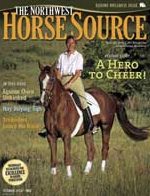As Published in the October, 2010, issue of The Northwest Horse Source.
You’re only riding your horse to and from your trailer or camp spot, and LNT just applies to camping right? Wrong.
Leave No Trace principles are just as applicable to the recreational trail rider as to the dedicated back country packer. In fact the actions of those of us that ride in the “front country” may even have more impact due to the greater number of users. We get so much enjoyment from trail riding that we should take every opportunity to make sure that trail restrictions do not increase and threaten our ability to ride on our favorite trails. As equestrian trail users we have wonderful opportunities to protect our trails from before we saddle up to when we arrive back at camp or trailer. These simple and easy Tips will help.
Before the ride – Before we take the first step on the trail we can start minimizing our impact by planning for the ride.
• Choose your trail wisely – Save rides in historically wet, or muddy, areas for times when conditions are typically drier. The object is to “Leave No Trace” and a horse on muddy or marshy ground is going to leave holes and churned mud. The whole idea of LNT is that no one will know you’ve been there.
• Practice with your horse at home – Make a point of crossing water, logs and other obstacles during your regular rides. A horse that fights his rider at a stream crossing is not only dangerous but tramples the bank and pushes sediment into the water. Backcountry horses need to be trained not only for rider safety but also to protect the environment. Getting lost causes undue damage to the land and considerable risk for rescuers. Carry and know how to use a map. Know your route and how to “Stay Found”.
During the ride – Once we get on the trail our opportunities to reduce our impact grow even larger.
• Travel on durable surfaces and stay on the trail. Don’t go around muddy areas should you come across them. Train your horse to go straight through. If you go around the trail will widen and become even muddier in the future. Mud is part of the backcountry challenge. Expect it.
• Also, refrain from cutting your own switchbacks or short cuts. After waiting all week to go trail riding why take a short cut just to get back quicker?
• Since horse’s hooves can exert pressures exceeding 1,000 pounds per square inch on trail surfaces the destructive potential from horses is significant.
• Stay in the center of the trail, single file, and avoid trailside vegetation areas. The one thousand plus pounds of pressure that a horse can put on the land can quickly trample and destroy off-trail areas.
• Don’t let your horse stop on the trail to make a deposit. Keep the horse moving, and the manure will naturally scatter behind, speeding up decomposition and causing less bother for other trail users.
• Pack out everything that you packed in. How does a 12 oz. can of your favorite beverage weigh more empty than full? If you take it out bring it back. This is a common failing that we as horse people are most guilty of. Keep our trails clean and enjoyable for years to come by simply “Packing it out”.
Taking Breaks – Not only can we be model trail users during our ride we can also extend this to our rest stops and breaks from the trail.
• Take rest breaks well off the trail on a durable surface such as dry grass, sand, or dirt.
• Pack “it” out – Dispose of all waste properly, including your own. This boils down to one simple thing “Pack it in-Pack it out”. There is no reason to see these “Trail Daisies”. Pommel bags can carry personal gear such as emergency kit, lunch, and a bathroom kit—a re-sealable plastic bag with toilet paper, a small folding shovel and other necessities. Follow leave-no-trace techniques to dispose of human waste.
• Tying to Trees – Horses should be tied to trees only for short periods of time. Select a live tree at least 8″ in diameter. To prevent most of the damage the rope can do to the bark wrap the lead rope around the trunk twice before you tie off. Also, teach your horse to tie and stand patiently. A horse that paws while tied will compact the soil, which not only leaves an unsightly ring but can damage or kill the tree.
• Practice “Leave Negative Trace” by leaving the trail in a BETTER condition than you found it. If you see an old can on the side of the trail pick it up and pack it out. Pick up any trash you find along the trail. A little preventative maintenance can make a big difference. Small bits of trash, such as soda and beer cans, cigarette butts, candy wrappers, twist ties, etc., are common trail eyesores and should all be packed out.
As our preferred mode of transportation becomes more and more common, equestrian trail users are being asked to minimize their trail impact by means similar to those used by hikers. By demonstrating our concern for trails as a sustainable resource, Horse riders can become leaders in LNT advocacy and in protecting our continued ability to ride in our favorite places.
For more Tips on trail riding, trail safety, and of course trail maps and Reviews, visit www.TrailMeister.com


